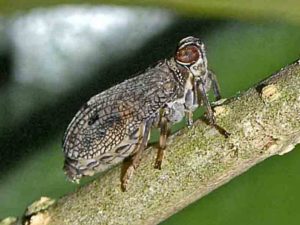COG PLANTHOPPER
The small planthopper pictured below is found throughout Europe, Russia, China, and Northern Africa. First described in 1839, it is a winged insect with more than 1,000 relatives. The nymphs are unique to their parents in a manner not found elsewhere on planet Earth. What is that unique genetic feature or attribute for this quarter-inch-long insect? Hint: The unique genetic mechanical feature is the only known example found in nature but may be found in every mode of transportation used by humans.

Answer
Some will argue that man has often invented things having closely observed nature. For example, it might be argued that observing nearly round rocks rolling down a hill provided the idea for the wheel. The Wright brothers are said to have observed how birds twist their wings and tail feathers to control their flight when developing controls for their aeroplane.
While the human concept mechanical gearing is more than 2,300 years old, Issus Coleoptratus nymphs (pictured in the question) have incorporated biological mechanical gearing in their hind legs for perhaps millions of years. It is the only known example of biological gearing. Gearing is defined as evenly-sized teeth or cogs cut into a matching pair of straight or curved, interlocking, moving, surfaces in such a manner as to synchronize their motion as they operate.
Investigated by biologists Malcolm Burrows and Gregory Sutton from the University of Cambridge in the U.K. in 2013, the gears force the nymph’s legs to each exert equal force when the nymph hops among undergrowth leaves and branches at speeds as high as 8.7 miles per hour. The gearing action ensures the insect jumps straight ahead and not off-course or starts spiraling only to miss the targeted landing spot. The x-ray images below show the 80 micrometer wide teeth that incorporate fillets to reduce wear at the base of each cog or tooth similar to human-designed mechanical gears.
 Each gear cog is also asymmetrical and curved in one direction only as the interlocking action between the teeth under power is in one direction only. Most man-made machine gears, such as those in transmissions and steering systems are symmetrical due to the need to rotate in two directions.
Each gear cog is also asymmetrical and curved in one direction only as the interlocking action between the teeth under power is in one direction only. Most man-made machine gears, such as those in transmissions and steering systems are symmetrical due to the need to rotate in two directions.

Interestingly, should a tooth break, when the nymph molts to a larger size, a replacement tooth is grown as each molting increases the size of the gears in proportion to the insect’s increasing mass and leg length. However, as a nymph becomes an adult in later molting events, the gearing disappears giving way to a simple friction interface between the two leg bones. This evolutionary change no doubt eliminates the need to grow back broken cogs during adulthood. The larger mated surface contact areas of adult leg bones provide the same control of landing location. Burrows and Sutton were able to observe, using high-speed video, the mechanical action of the Issus Coleoptratus’ legs by electrically stimulating one of the nymph’s leg muscles causing the pair of legs to quickly extended with synchronized force and motion.
